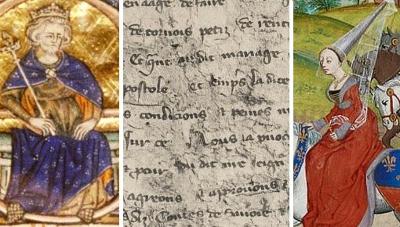The marriage contract of Edward II, 1303
This is the story of a document held at West Glamorgan Archives, which played a crucial part in the tragic life and death of one of England's medieval kings.


Edward II was not a successful king. He reigned at a time of turmoil between king and barons and there was a constant threat of civil war. Pursued by his wife, arrested, deposed, imprisoned and murdered, his is a tragic story. He is widely believed to have been gay and had close relationships with his advisors Piers Gaveston and Hugh Despenser, Lord of Glamorgan.
Edward was born in Caernarfon, the son of the formidable Edward I, and in 1301, at the age of 16, he became the first English prince to be named Prince of Wales. He was 'tall and strong, a fine figure of a handsome man'. Active, accomplished and fond of music, he was initially very popular, but this was not to last.
Here at West Glamorgan Archives we hold the document that marks a pivotal moment in his life: dated 20 May 1303, it is his marriage contract with Isabella, daughter of King Philip IV of France and Queen Joan de Navarre. Isabella was then aged about 8, and its purpose was not romance, but rather to secure peace between England and France after years of tension. The marriage took place in 1308, by which time Edward had become king.
Four years later, in 1312, Swansea Borough petitioned for a confirmation of the royal charter they had received from Henry III in 1234. This they duly received, sealed by Edward II, and it is also held at West Glamorgan Archives.

Despite her frustration with the king's preference for Gaveston, Isabella was initially supportive of her husband, but she took exception to his new favourite Hugh Despenser, whom she loathed. She became increasingly excluded by Edward and Despenser and by 1322 the king and queen had effectively separated. In 1325, she was sent to France to negotiate a treaty. While she was there she decided she could stand it no longer and refused to come home. She joined forces with the exiled baron Roger Mortimer and the two returned to England with an army, intent on deposing the king.
Edward fled to Wales in panic, sending documents and treasure ahead to Swansea Castle for safe keeping. His aim was to make for Lundy Island and cross from there to Ireland to raise an army, but storms prevented him. He took refuge where he could, in Cardiff, Caerphilly, Margam, Neath Abbey and possibly Swansea, but it was all in vain. On 16 October 1326 he was arrested, near Neath or Llantrisant. On 21 January 1327 the king was forced to abdicate and was imprisoned in Berkeley Castle, Gloucestershire. The circumstances of his death are mysterious, and most historians agree he was murdered.
What happened next? Read about the marriage contract and how it came to be in West Glamorgan Archives.
